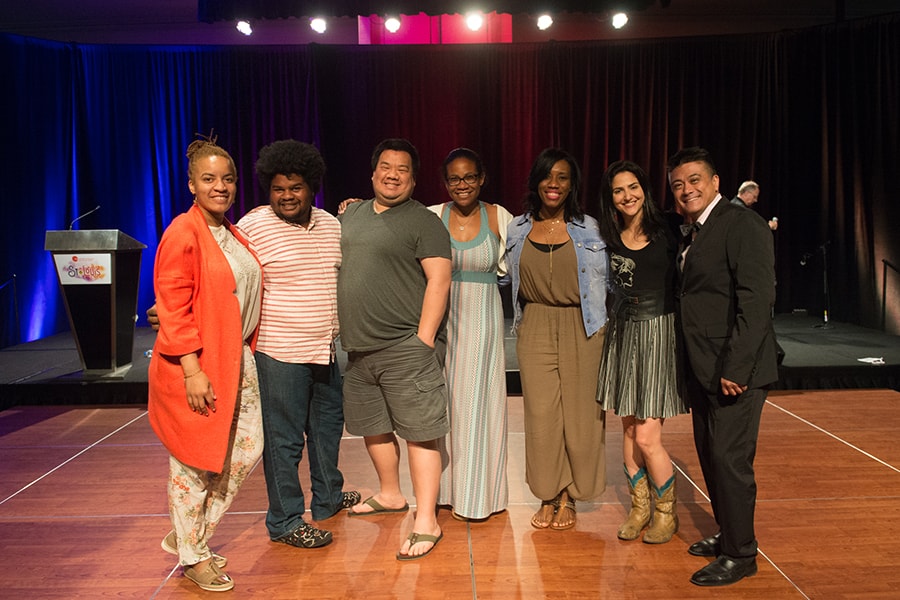“This is my kind of professional development,” I thought as I sipped an umbrella drink at a local St. Louis restaurant. It was the inaugural dinner of the Rising Leaders of Color cohort. Sponsored by TCG, the program gives young theatre artists of color professional development opportunities. I had applied as the arts journalist/critic of color, and was reflecting positively on my choices. Everyone was nice, funny, and smart, and we quickly found common ground.
Then the workshops started, and we were challenged to figure out our values and goals, and determine who we were as artists. The conversations dug a little deeper as we questioned how to show up as our authentic selves in spaces where we felt, if not unwelcome, at least ill at ease, and in those spaces, how to show up for all the people we carried with us, who may never get into those rooms with us. There were no easy answers, but maybe answers didn’t matter as much as working through them did—and seeing that we weren’t the only ones struggling with the questions.
For us artists, there was before RLC and after RLC. The program is just “professional development” the way a Tesla is just a car. Sure, you widen your network, get resources to develop as a leader, explore and refine your mission as an artist. (As an arts journalist, RLC also made it possible for me to attend the O’Neill Critics Institute last summer.) But it’s also something more. The entire 2018 cohort, including myself, comprised 10 artists, including Pia Haddad, Peter J. Kuo, Ariel Estrada, and Sophie Ancival. For this article I spoke to the five participants based in my hometown of St. Louis, who shared with me how the experience of this program forced them to confront themselves as artists, and in so doing to change as people.
Bryce Goodloe
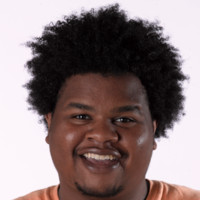
Originally from Memphis, Tenn., Goodloe came to St. Louis to study business, theatre studies, and dramaturgy at Webster University. As a student, he worked at the Repertory Theatre of St. Louis and Opera Theatre of St. Louis, but he felt something was missing. So he started working for a smaller theatre company, Gitana Productions, on Black and Blue, a play by Lee Patton Chiles about the unrest in Ferguson following the killing of Michael Brown.
“The curriculum [at Webster] was as binding or world-opening as you wanted it to be,” says Goodloe. “But it was all still from a Westernized point of view.”
When he heard about the Rising Leaders of Color program through his current employer, Shakespeare Festival St. Louis, where he is a development assistant, he thought it might be able to fill in some of the gaps.
“Once I read more about it, I realized there were so many connections that could be made from joining such a great group,” he says.
Goodloe wants to work in a space where LGBTQ issues, community activism, and the African diaspora can intersect. But before RLC, he found that to “navigate the world that was professional theatre, professional arts making, and culturally diverse and community-driven art activism was a little fuzzy.”
Now, after RLC, he’s realized, “There’s no one way to do it. But we’re people of color. You’ve got to have some kind of rubric, some kind of layout to know the playing field. And I was given a road map that showed me several directions to my true trajectory.”
Carl Overly Jr.

No one person is the heart of the St. Louis theatre scene, but Carl Overly Jr. comes close. Connected to nearly everyone, and so beloved that a friend made T-shirts with “Hey, Carl” and his picture on them, Overly is the go-to guy when you need almost anything: an actor, casting help, or an introduction to another theatre worker.
Despite his ubiquity, Overly still didn’t felt like he had access to the top leadership of the theatre world until he became a Rising Leader of Color and went to his first TCG conference in June 2018. “It was nice to be in the room where it happens,” he says.
When he applied to RLC, Overly was working in the St. Louis theatre community as an actor, performing with St. Louis Black Rep, Shakespeare Festival St. Louis, Upstream Theatre, and St. Louis Actors’ Studio, among others. He also worked as a teaching artist with the Prison Performing Arts program.
In the past year he directed his first play, The Motherfucker with the Hat by Stephen Adly Guirgis, for R-S Theatrics, moderated discussion panels on representation, and decided to leave his day job in special education to be a full-time artist.
“It’s nerve-racking,” he says. “But I’m ready to do it.” Part of the urgency in making the change was brought on by his participation in the RLC.
“You get in the business of being onstage and performing,” says Overly, “but this made me see I want to use my voice for more social justice and be an advocate for other artists of color.”
Gabe Taylor
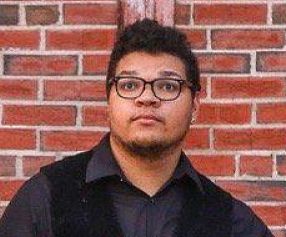
During last year’s RLC pre-conference workshop, Gabe Taylor had a revelation. “Just because you’re good at something doesn’t mean you should be doing it if it doesn’t bring you any artistic fulfillment,” he says. As a result, “I’ve stopped stage managing except for projects I really want to work on, and the RLC program helped me give myself the permission to take that step.”
When he applied to the RLC, Taylor was stage managing, directing, acting, and designing. He was also an associate artistic director for Theatre Nuevo (started by fellow cohort member Anna Skidis Vargas, see below) and Equally Represented Arts, both companies focus on new and experimental works, with Theatre Nuevo staging more Latinx works.
Today Taylor has primarily jettisoned the stage managing and is co-artistic director of Theatre Nuevo. Over the last year, he directed, designed, produced, and co-wrote whither should I fly as part of the 2018 FAUSTival, for which theatre companies around town reimagined the Faust story. (Taylor also appeared in many of other shows at the FAUSTival.) For Theatre Nuevo he’s also working on an intimate production of Fefu and Her Friends, by late Cuban American playwright Maria Irene Fornés.
While Taylor’s background and experience prepared him for his burgeoning leadership role in the St. Louis theatre scene, he also acknowledges the debt he owes to the RLC.
“The intergenerational Leaders of Color/Theaters of Color meetings have been incredible,” he says. “Hearing the same struggles from artists who have been working in and disrupting the field for years gave me a lot of hope.”
Jacqueline Thompson
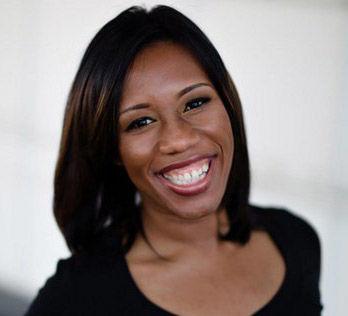
When she was selected by TCG, Jacqueline Thompson, assistant professor of theatre at the University of Missouri–St. Louis, had already been called one of St. Louis’s most versatile performers, had appeared in shows with nearly every theatre company in town, and directed productions at UMSL and around the country.
Just as she was starting the RLC program, though, rumors began circulating that the theatre department at UMSL would be closing due to low enrollment. A few months later, Thompson was moved to the communications department, where she will still teach acting but won’t stage anymore productions. Fortunately, the RLC offered the requisite support during the upheaval.
“The program did the interpersonal work that I didn’t know I needed,” Thompson says. One activity, figuring out individual core values, “grounded me not only in my artistry, but as a human, to think about what are some things that you really value and how do those things help you or hinder you navigating life.”
Since the TCG conference, Thompson has acted, created a show with her students about James Baldwin called From Jimmy, to America: An Ode to James Baldwin, and directed multiple shows, including Lynn Nottage’s Crumbs from the Table of Joy in St. Petersburg, Fla. She also won a St. Louis Visionary Award for her impressive theatre career.
Thompson was most excited about getting the RLC recognition because it forced her to speak out. “Being in the RLC has made me accountable for having a voice in some of the things that are happening in this city as it relates to our craft,” she says. “That’s been so important.”
Anna Skidis Vargas
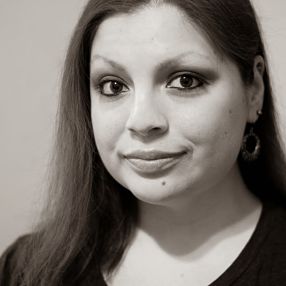
When Anna Skidis Vargas got accepted to the RLC program, she was already busy—very busy. In addition to acting around St. Louis, she had started Theatre Nuevo in 2015, been accepted into graduate school for the 2018 academic school year at University of Texas at Austin, and had just gotten married. Even during the TCG conference she was busy directing Alvaro Saar Rios’s Luchadora at Mustard Seed Theater.
When Vargas got to UT Austin, she did not slow down. During her first year in the MFA directing program, Vargas directed five shows, including one at the UTNT (University of Texas New Theater Festival) and one for the Cohen New Works Festival, Lloronx, which she wrote with the help of her ensemble. The “unapologetically Latinx” piece reimagines the popular folktale La Llorona and upends Latinx stereotypes of la virgen, la madre, y la puta (virgin, mother, and whore). She’s next set to direct her biggest production yet, Spring Awakening, at UT this fall.
So for Vargas, one very positive result of RLC was having mentors like Paul Robinson, a workshop leader, and Emilya Cachapero, director of artistic programs for TCG, who participants talk with throughout the year.
“It helped me reground and dig my feet in and get shit done,” she says about a phone call with Robinson that came right when she needed it.
But most inspiring for Vargas were the connections. “Getting to be in a room and talking with other artists who know the same kind of stress and extra weight that you’re feeling as a person of color, that was probably the most special part of the experience.”
As a cohort we continue to receive support from TCG, including future workshops through the program. Speaking for myself, as an arts journalist the last year has been as edifying as it was transformative, giving me an entirely new perspective on theatre and myself. The program promises to continue prodding us all to stretch ourselves, speak up in our communities, and rise as leaders. We haven’t just made it into rooms where art happens; to a new and growing extent, these rising leaders are making whatever room they’re in the room where it happens.

